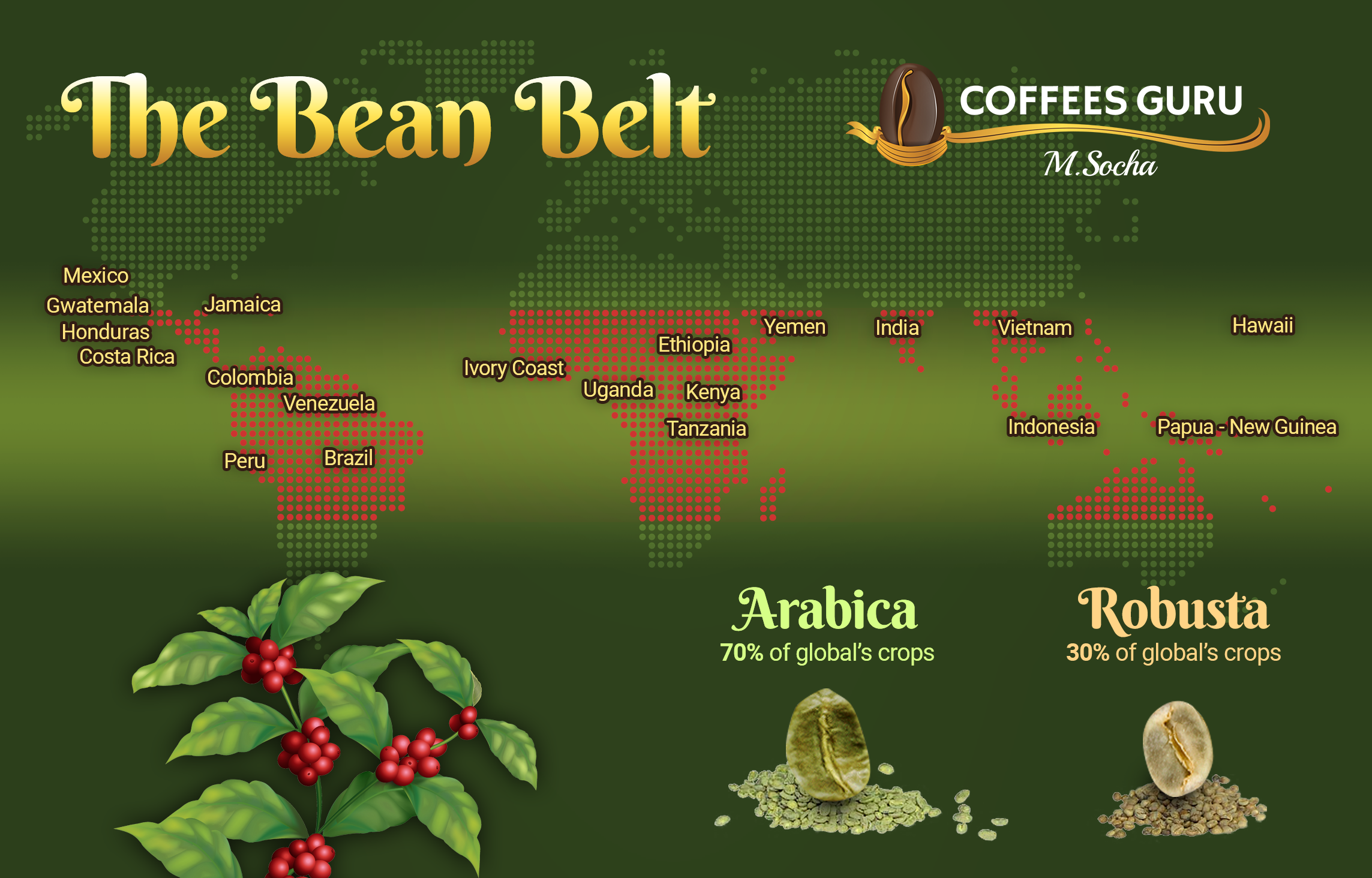You often ask me what differs African arabica from American arabica, how to grind coffee so it matches a specific brewing method or which roasting level will be the best for you. So, this article will contatin some information, that can help you answering these questionns.
Arabica or robusta?
There are 2 different variations of coffee that are cultivated worldwide: arabica and robusta. The first of the two is considered a higher quality than the second. Arabica accounts for about 70% of world’s coffee cultivation and robusta around 30%. Robusta is sometimes added into mixes of other variatons of coffee to make them “stronger”, but it’s not necessary. In Single Origin roastery, we only offer arabicas.

What’s different between coffees from different world regions?
Both arabica and robusta have their own variations. The most popular method of dividing coffees is by originating country and region. Coffee is cultivated in so called coffee bean belt defined between the Tropics of Cancer and Capricorn. Arabica has lots of variations, but coffees cultivated in same regions have some similar features:
– Africa – coffees from this continent are slightly acidic (but they are not sour – you don’t need to worry!), they have citrus fruit notes and are rather delicate. I highly recommend Ethiopian arabicas from Sidamo and Yirgacheffe regions – these are the great coffee classics, which are worth a try.
– Central and South America – American coffees are low acidic, have nut and chocolate notes. Their flavor and aroma are considered as “classic coffee”. Brazilian arabica „Santos” is very popular, but there are equally great coffees coming from small New World’s countries, e.g. Costa Rica Tarrazu.
– Asia – Mostly Indonesia, Papua New Guinea and India. Asian coffees are very low acidic, have “ground/earthy” and “forest” notes. Even though novice coffee drinkers often don’t like their “muffled” character, they have many admirers.
How important is fresh roast?
Coffee is a long term product. Most of big producers determine coffees expiration period for 2 years. However, there is a huge quality gap between coffee roasted a week ago and coffee roasted a year ago. It can be compared to bread. Most of you, probably, like bread straight from the bakery – fragrant, crunchy, just fresh. The same bread can be eaton 2 or 3 days later, but will it still be the same?
It’s similar with coffee – you should drink it in 4 weeks after roasting, during this time it will taste the best. Single Origin roastery doesn’t roast coffee to store it for later – every kilogram of coffee is roasted for a specific customer.
Coffee roasting types:
- Unroasted coffee, raw green beans.
- Light (New England)
- Medium (American)
- Medium dark (Vienna)
- Dark (French or Italian)
In roasteries, raw, green coffee beans undergo thermal treatment (even 250°C), thanks to that we can extract their flavor and aroma. Raw coffee beans have only a several dozen aroma-flavor compounds and their roasted counterparts above 700! Every variation of arabica, depending on many factors, has a roasting level, that enables to unleash the specific coffee beans potential.
General rule is that, the more delicate roasting level, the more noticeable natural flavor notes of specific coffee are.
Stronger roasting levels minimalize acidity, but at the same time make different coffee beans more similar to each other. Single Origin roastery allows every coffee lover to experiment with roasting levels. However, if coffee roasting levels are still a mystery to you, rely on our recommendation
Buy ground coffee or grind it yourself?
Of course grind it yourself! Whole bean coffee can keep it’s high quality for a long time, but ground coffee loses it’s flavor and aroma quick. Grinding coffee just before brewing is the easiest method to make your coffee even 50% higher quality.
If you have a coffee maker with built-in grinder, then you don’t have to worry and if you brew your coffee in a different way, you should consider buying a coffee grinder and grind your coffee beans yourself. It’s worth to remember that different brewing methods need different grinding levels:
- fine – for espresso machines.
- medium – for percolators, drippers, filters and AeroPress.
- coarse – for French press and jugs.
At Single Origin we offer grinding coffee for you – we are aware that not everyone has a grinder or wants to do it by him/herself. But I will always encourage you to grind coffee yourself, because it’s the easiest method of improving it’s quality.